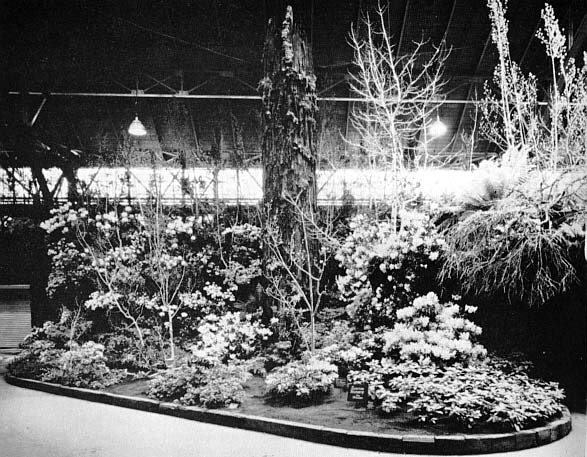California Spring Garden Show (1961)
Edward H. Long, President California Chapter

|
|
Fig. 39. California Chapter A.R.S. Exhibit at the Oakland Flower Show
Photo-Art Commercial Studio |
The California Chapter of the A.R.S. were presented with first prize award for "Agricultural Merit" in the amateur division for our garden landscape at the now famous California Spring Garden Show of 1961. Going with this was the Abe P. Leach silver cup and a substantial cash prize. This was a notable award as the Garden Show has won national acclaim for its high standards of achievement. (Fig. 39)
For the second year the Garden Show won the bronze Bulkley Medal of the Garden Club of America for an exhibit of special merit. This is the first time this medal has been given to an entire show. The theme of the show "Happy Isles" with its naturalistic back-ground. dramatic use of water and exquisite plant material presented a beautiful and harmonious display of great merit.
The show was designed by Howard Gilkey of Oakland. The show covered a naturalistic redwood forest on the slopes of the high Sierra Mountains with a rushing cascade of water emptying into flower lined pools of the landscape. Additional landscapes were the inspiration for world fanned displays of rhododendrons, azaleas and orchids. Giant Sequoias, tree ferns and choice Philodendrons were beautifully displayed.
A tropical island scene with South Seas locale was seen through a soft falling Polynesian water curtain framed in ferns.
The main attraction of the California Spring Garden Show was the multi waterfall which the show designer, Mr. Gilkey, located at one end of the building. The water became visible as it shot out of various rock outcroppings and tumbled down half a dozen ways to finally end up in a large lake. Right adjacent to this very naturalistic setting was the space assigned to the Rhododendron Society.
It was mandatory to design an exhibit which would continue this woodsy effect. The space had a 60' frontage with a depth from 15' to 25'. The total background was treated like a cliff covered completely with moss. Almost in the center of the exhibit was a large Redwood tree with a trunk of 6' diameter at its base. The tree had been defoliated by lightning which at the same time left burned streaks along the tall trunk. In some of the scars, ferns had found a home and reminding the viewer that plant life never ends.
The designer was very much aware of the role which the American Rhododendron Society should play when entering such a flower show. Most exhibitors are commercial nurserymen and they show only species and hybrids of rhododendrons and azaleas which are plentiful in supply.
For this reason, Mr. Wertheim, attempted to use plants which were not as well known to the public. The more commonly known species and hybrids were used more as a background while the choicest materials were placed where the visitor could study them and also read the label.
One side of the cliff was covered with azalea Glen Dale var. 'Glamour.' These plants which were loaned through the courtesy of the Strybing Arboretum were between six to seven feet in diameter and gave a lovely effect as they drooped over the cliff On the right side of the Redwood about 15' above the observer a grouping of Rhododendron 'Earl of Athlone' gave depth to the exhibit. The red flowers twinkled in the sunlight which entered from the sky lights above. Right below it almost at the level of the observer several large Exbury specimens in light clear yellow shades gave life to an otherwise very dark corner. The Exbury Azaleas were at the height of their blooming period as the show started. To avoid having a dead spot toward the end of the ten day show the designer placed a group of azaleas just adjacent to the Exbury group. These plants were covered with light green foliage and the flower buds burst open during the middle of the show shifting the attraction from the Exbury group.
Through the lower part of the exhibit a trio of Aspen trees was displayed in order to give a third dimension to the foreground. A special space was given to R. 'Full-loon', R. 'Carita', R. 'Alice Eastwood' and R. 'CIS' with a ground cover of white and pink 'Gumpo' azaleas.
To catch the eye even in a deep corner. Mr. Wertheim used
R. macabeanum
. The large leaves in their grayish blue color made a lovely contrast to the blooms of R. 'Jean Marie de Montague.'
There were many other interesting plants on display but they are too numerous to mention here except for the tremendous R. 'Fragrantissimum' specimens. These plants were inserted into pockets of the cliff and they gracefully hung down and with its tremendous fragrance gave a wonderful effect. By one upright specimen of R. 'Fragrantissimum' was planted azalea 'Susan Land', the rich color of this azalea was masterfully displayed against the white blossoms of R. 'Fragrantissimum' and
Peris tremula
.
Great care was taken to have harmonious color effects and not to overcrowd the exhibit with all kinds of species. The total exhibit had an airy feeling. The success of this exhibit is due to the unselfish help of many of the members who worked hard and others who let us have their choice plants. In particular thanks should go to the show chairman who devoted many weeks to the preparation of this beautiful exhibit, Mr. Thomas Russ.